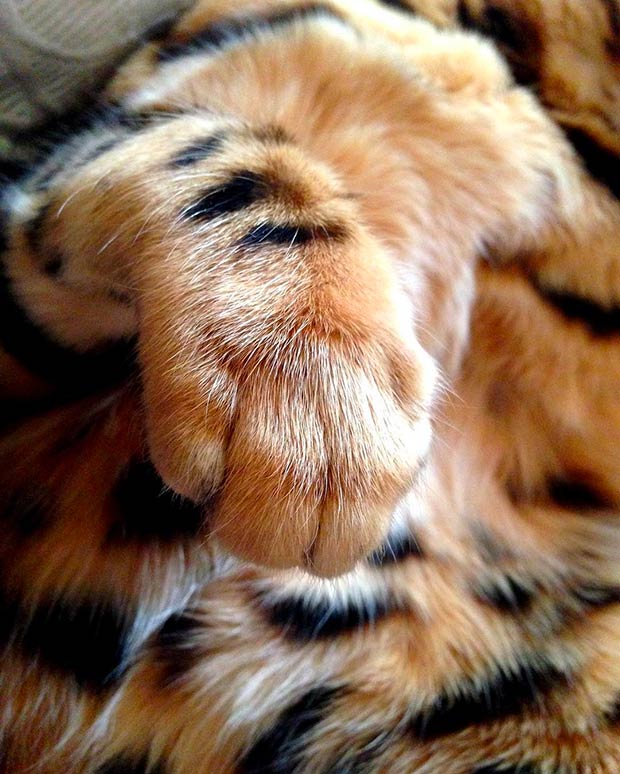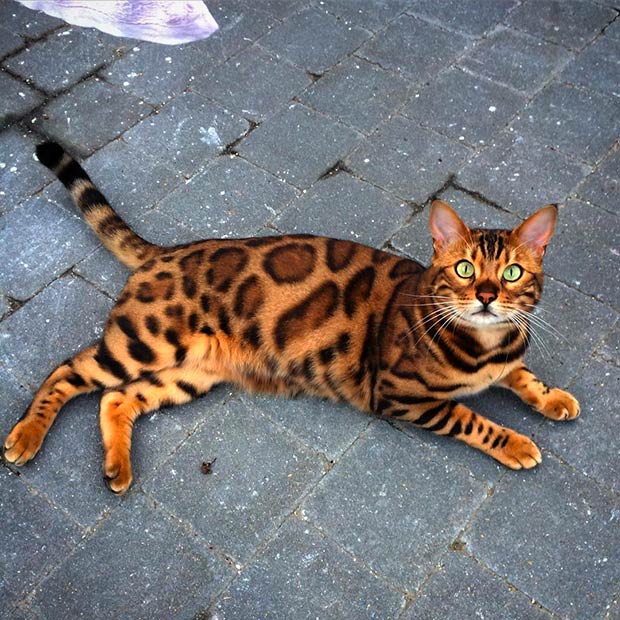[dropcap]T[/dropcap]his adorable tiger-striped kitty could, quite possibly, have more Facebook and Instagram followers than you! Meet Thor- a Bengal cat from the Netherlands, who looks just like a cute baby tiger, and has the internet awwwing in unison over him.
“We actually came to look at another kitten, but then the breeder said she had another one that was available and then she came with Thor in her hands,” says Thor’s owner, Rani, in an interview with the Huffington Post.
“We immediately fell in love with his beautiful ‘orange-brown’ colors.”
Adopted by Rani Cucicov, a Belgian resident, in 2013, Thor has an active social media following, with accounts on Facebook and Instagram, and a multitude of adoring fans, more loyal than Kim Kardashian’s.
“My name is Thor. I am a Bengal living in Belgium. This is my Facebook page that is runned by my servants,” says Thor in his Facebook description page. “Hope you enjoy my daily adventures!”
Thor spends his time uploading the cutest videos of him getting chin rubs from his servants (read: owners) and often posts pictures on important issues of the day like “fluffy pawpaws”, naptimes and “shrimpies”. You can also catch kitty pictures of Thor, tagged as Throwback Thursdays.
Catch Thor on Instagram here.
A cross breed between an Asian leopard cat and a domesticated housecat, 3-year-old Thor has the most gorgeous striped and spotted fur, which makes him look like a cute cross between a Bengal tiger and a leopard.
The Bengal cat is an artificially synthesized breed developed to resemble exotic jungle cats such as leopards, ocelots, margays and clouded leopards. The name Bengal is said to be derived from the Asian leopard cat’s scientific name, Prionailurus bengalensis. It is also a reference to these cats largely resembling Bengal tigers, in terms of fur, markings, and gait.
The first instance of breeding between an Asian leopard cat and a house cat, was reported by Jean Mill, a breeder in California, in the 1960s. Having acquired a leopard cat, she let a black tom cat keep her company, resulting in spotted kittens. It came as quite a surprise to Mill, who hadn’t expected the two to mate.
Throughout the 1970s and 1980s, Mill grew to be a notable developer of Bengals like Thor.
[ads2]
Some cool facts about Bengals
[tie_list type=”lightbulb”]
- Bengal cats weigh 8 to 15 pounds, sometimes more.
- The highest price paid for a Bengal cat, was $50,000, by a British woman, who also dubbed them the “Rolls Royce” of feline companions.
- Bengals, today, are just as tame as any other domesticated house cat, provided they are at least four generations away from any wild ancestors.
- The Bengal is a highly intelligent, active, alert and friendly cat. They have extremely nimble, and sure-fingered paws.
- Some Bengals have a clear ‘M’ on their foreheads.
- Most Bengals have defined “rosettes”- where each individual spot has an outline of a darker colour, making them resemble a jaguar. Not all Bengals have rosettes though; some have spots more like that of a leopard, with no outline of color.
- Unlike most domestic cats, Bengals love water! So much so, they have no fear of getting wet, and will gladly frisk about under taps, sometimes even following their owner into the tub or shower!
[/tie_list]
You can find more cool facts here.
Thor’s Gene Pool And History
Bengal cats, which are a crossbreed between domestic house cats and the Asian leopard cat, found their earliest mention in 1889, when Harrison Weir wrote of them in Our Cats and All About Them. Looking very like a wild cat on the prowl, the Bengal, is, however, domesticated through and through.
Descending from Mill’s surprising experiment in the 60s, Bengal cats have since been developed on a large scale, as they demonstrated an interesting trait.
Scientists in the 1960s discovered that leopard cats were resistant to the feline leukemia virus, which led them to experiment and see if the trait could also be passed on to hybrid offspring.
Characteristic Bengal Cat Traits
[tie_list type=”checklist”]
- Bengal cats are among the most playful and intelligent of housecat breeds there is. They love frolicking in water and playing under a tap.
- Bengals are inherent hunters, and may try to kill smaller pets or animals such as mice, hamsters, and guinea pigs. It’s best to keep them away from smaller house pets.
- You needn’t worry about your Bengal cat getting along with other pets, though: they befriend and get along with dogs and other cats famously.
- Bengals are excellent jumpers and climbers, so much so, they actually appear to be “flying”, at times. Bengals can jump up to three times their height and are great at finding excellent hiding places.
- Despite their fierce looks and gait, Bengals are some of the most gentle cat breeds to be found. They usually play with their claws retracted and are particularly gentle around babies.
[/tie_list]
Coat Characteristics
The soft, sleek and shiny coat these magnificent cats possess, have two basic fur patterns: the more common spotted pattern and the wonderfully swirly marbled.
Their spots can be of two types- either with rosettes, giving a jaguar like appearance, or without rosettes, in which case the fur resembles that of a leopard.

If you’re looking to purchase a Bengal, here are some important things you should keep in mind
[tie_list type=”lightbulb”]
- Bengal cats as housepets, need to be at least four generations removed from any ancestors with wild bloodlines.
- You can play games, including fetch, with your Bengal kitty. They are also really good at learning tricks, and posing for cute photo-ops.
- The Bengal is a really playful breed: Don’t be surprised if you find yours flicking on and off switches, jumping into tubs or your shower, and pulling magazines and CDs out of their racks.
- They love climbing, so it’s a great idea to have a tall tree or a scratching post in the house, to prevent your kitty from ruining the good furniture. It is also not uncommon to find Bengals perched at the highest point in the house, or even swinging from chandeliers.
- It is a good idea to keep your Bengal cat indoors. This keeps him protected from diseases spread by other cats, attacks by dogs or coyotes, and other dangers, such as being hit by a car, or even the risk of being stolen.
[/tie_list]
Health
Bengal cats, especially those under one year of age, can develop distal neuropathy, a nervous system disorder that causes weakness. Most cats recover on their own, though.
Here are some of the other diseases Bengal cats can develop-
[tie_list type=”plus”]
- Flat-chested kitten syndrome, a deformity that can range from mild to severe. Most adult cats are spared, however.
- Hip dysplasia.
- Hypertrophic cardiomyopathy, a form of heart disease that is heritable in some breeds.
- Patellar luxation, a hereditary dislocation of the kneecap that can range from mild to severe.
- Progressive retinal atrophy, a degenerative eye disease.
[/tie_list]
Care
Bengals possess a short, thick coat that doesn’t require much care and maintenance. A quick weekly comb down to remove dead hair and distribute skin oils is a good idea, though. Baths aren’t usually required. (Most often, your kitty will just jump into the shower with you.)
It’s best to brush your cat’s teeth daily, or at least weekly, to maintain dental hygiene and keep her free from periodontal disease, and gum afflictions. It’s also good to trim the cat’s nails weekly, and wipe the corners of their eyes with a soft, damp cloth to remove any discharge.
It goes without saying, of course, that you should use different cloths for each eye, to prevent the spread if infection.
As for all cats, keeping the litter box spotlessly clean, is a must, or scrupulous cats might get put off by the dirty box and start using other places in the house. You don’t want that!
Here are some fun things you can do with your Bengal.
[tie_list type=”lightbulb”]
- Play games, such as fetch, or let him make up his own game with a ball of wool.
- Bring him puzzle toys to solve: Bengals are highly intelligent cats who love puzzles and games.
- Let him into the shower with you sometimes: Bengal cats absolutely adore playing in water!
- Get a tall cat tree or two, and let your kitty climb his way up.
- Teach him tricks: Bengals are whizzes at picking up tricks, respond quickly and seem to “get” things much faster than other cats do!
[/tie_list]
Bengal cats make lovely, adoring, and intelligent pets; however, they do require a high degree of care and attention. They also live from seven to nine years. Opt for a pet only if you are absolutely committed to taking care of one.

To quote Thor himself (right from his Instagram account),
“I gotta say that I’m pretty shocked that my picture has been going viral this week??”.




